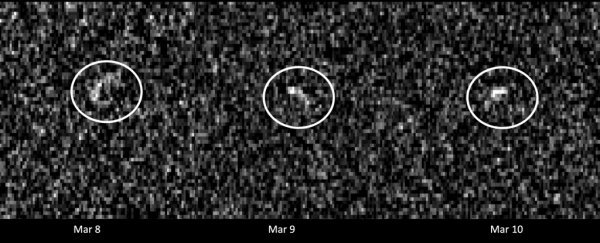When it comes back around again in 2068, the asteroid Apophis will have practically no chance of hitting Earth.
In fact, the 370-meter (1,210-foot) chunk of space rock won’t pose any sort of danger for at least another century, leading to its removal from both the ESA’s Risk List, and NASA’s Sentry Impact Risk Table.
“With the support of recent optical observations and additional radar observations, the uncertainty in Apophis’s orbit has collapsed from hundreds of kilometers to just a handful of kilometers when projected to 2029,” said astronomer Davide Farnocchia of NASA’s Center for Near-Earth Object Studies.
“This greatly improved knowledge of its position in 2029 provides more certainty of its future motion, so we can now remove Apophis from the risk list.”
Apophis was first discovered in 2004, and initial projections suggested the asteroid had a worrying 2.7 percent chance of impacting Earth in 2029. Although this was quickly ruled out, Apophis has a close approach to Earth roughly every eight years; because its orbit has been tricky to observe and characterize, the possibility of an impact at a later date remained undefined.
Gradually, over the 17 years that astronomers have been watching Apophis, its path through space has become clearer.
Last year, the biggest danger was determined to be the asteroid’s 2068 close approach. Farnocchia and his colleague David Tholen measured the Yarkovsky effect – that is, the heating on the asteroid’s Sun side that generates a small amount of thrust – and found that it generates 170 meters of drift a year.
The other big potential problem affecting the asteroid’s path is that 2029 flyby. According to projections, Apophis will fly past Earth at a distance of just 38,000 kilometers – roughly 10 times closer than the Moon. At that proximity, Earth’s gravity will affect the asteroid’s orbit, possibly bringing it closer to a collision course.
With these two influences in mind, the astronomers recalculated the projection of Apophis’s path. The chance of impact in 2068 remained. It was only one in 150,000, but that’s still a concern, considering how much damage it could do.
Now more data has been added to the calculations. The asteroid’s most recent flyby was just a few weeks ago – on 6 March 2021, Apophis came within 16.9 million kilometers of Earth.
For months prior, it had been visible in the sky, and astronomers watched it closely; then the March 6 flyby allowed scientists to narrow down its location to an incredibly precise distance of 150 meters.
In turn, the finding allowed for further refinement of the projections, and we’re now officially safe from Apophis for a very long time indeed. Considering that the asteroid has been sitting on the Risk List and the Sentry Impact Risk Table since it was discovered, this is a big relief.
When Apophis does swing by in 2029, it will afford scientists an excellent opportunity to study its size, shape, and spin rate, without the threat of doom looming, too. It will be the last such opportunity for a while – after 2029, its ‘close approaches’ will grow more and more distant.
“When I started working with asteroids after college, Apophis was the poster child for hazardous asteroids,” Farnocchia said.
“There’s a certain sense of satisfaction to see it removed from the risk list, and we’re looking forward to the science we might uncover during its close approach in 2029.”
